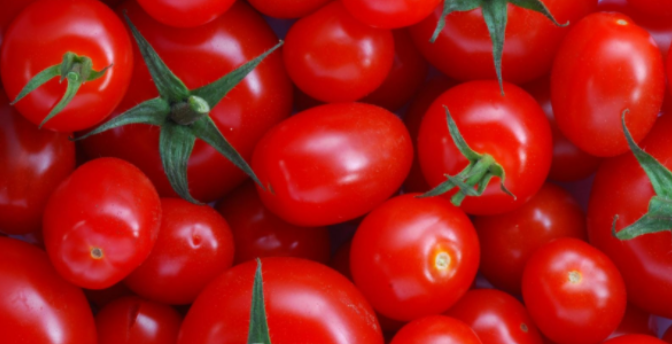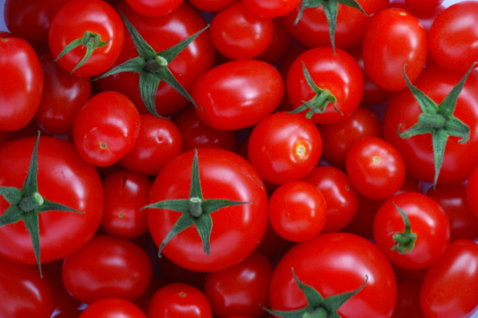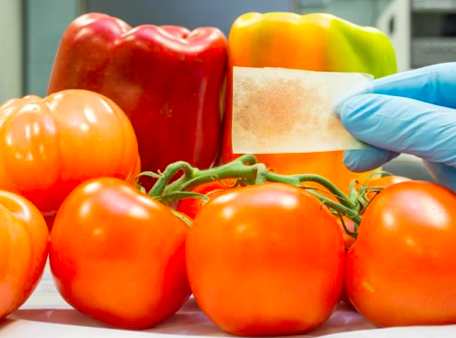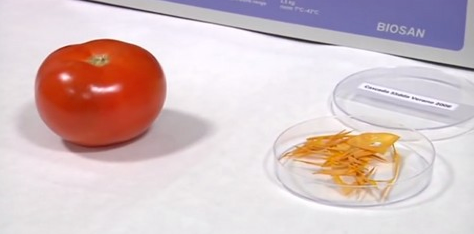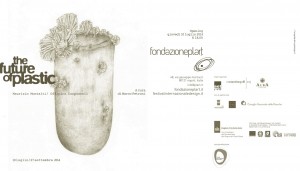di Chiara Catgiu
A new fully sustainable and biodegradable plastic has been obtained from the tomato peel and it has been discovered starting from different projects and collaborations.
The EU-funded BIOPROTO (Bioplastic production from tomato peel residues) project main objective is in fact the fabrication of bio-plastics from the tomato fruit peel residues. They are an abundant and inexpensive waste from processing tomato industries rich in polysaccharides (chiefly cellulose, pectin and hemicelluloses) and lipids (soluble waxes and a non-soluble long- chain biopolyester named cutin). Specifically, the project is focused on the bio-mimicry of the plant cuticle that is the protective and outermost membrane that covers the plant epidermis of parts of plant organs exposed to air.
The main aim in this project, the production of plant cuticle-like plastics has been divided in two: first, the synthesis and characterization of plant cuticle-like polymers from model substances and, second, the production of tomato peel plastics. These agro-wastes have been chosen because they have an elevated amount of cutin and the crop of tomatoes is an important business in the sector of the agriculture.
The European tomato processing industry processed 11,380,100 tonnes of raw tomatoes in 2004. Italy is by far the most important producer of processed tomatoes in Europe with a 53% share of European production followed by Spain (22%) and Portugal and Greece (10% each). Other minor producers include France and some of the new member countries, in particular Hungary and Poland. Nowadays, this inexpensive sub-product, tomato pomace, is used as animal feed.
Since the beginning of the project, different approaches have been developed to produce these new bio-plastics, Basically, they have consisted of a chemical synthesis in a very strong acid medium, a self-assembly process in water and diverse green and soft industrial processes. Also, a comprehensive study of the refinery of the tomato fruit peel residue from a perspective of IR and Raman spectroscopies has been carried out. On the other hand, interestingly, a new set of films and coatings from the lipid fraction of plant cuticles has been produced and characterized.
Despite the inherent difficulty of the combination of polysaccharides and lipids, main results achieved so far are ascribed to the development of a scale-up process for the fabrication of lipid- cellulose materials (bio-plastics) with potential applications in food packaging. Additionally, the critical reviews on IR and Raman features of plant cuticles has generated significant interest among specialists in the field.1
Another interesting and similar research project is taking place at the Italian Institute of Technology in Genova, Italy, in collaboration with the Centre for Scientific Research of Spain and the University of Malaga.
“It takes up to 4 years of research to get a product ready to be launched on the market – says Athanassia Athanassiou, IIT researcher and manager of the Smart Materials research group – taking inspiration from nature we have reproduced in the laboratory a biocompatible, biodegradable plastic coating 100% obtained from pepper and tomato peel and which retains the properties of the original product.“ 2
Natural occurring polyhydroxylated fatty acids from tomato peels are excellent raw substances for the fabrication of different materials such as free-standing films, cellulose composites and coatings for cans.
They can be easily polymerized, by using a solvent-free melt-state process in very short times. The resultant materials shows a high hydrophobicity, good water and oxygen barrier properties, low opacity values, full biodegradability, and high adhesion to different metal substances.
The main potentially exploitable markets are packaging, paper industry, textile industry, health care and food industry.
The same project developed at the Centre for Scientific Research of Spain and the University of Malaga aims instead at exploiting the natural viscoelastic properties of tomato peel, as well as its waterproof nature and protection capacity against other liquids, as well as parasites; a discovery that could also in principle be extended to other vegetables, such as bell peppers. However, scientists have prioritized tomatoes, particularly because the industry tends to discard the peel, which is usually discarded after the tomatoes are peeled for canning.
The Professor of biochemistry Antonio Heredia and the scientist José Jesús Benítez, co-authors of the research study of the IIT, have worked with various kinds of vegetables until this discovery was made and patented. The most notable development from an environmental standpoint, also in this case, is the minimal impact that this use of the peel has, with the plastics produced being also biodegradable in the short term.
In this research, through a process of in vitro depolymerization, the original tomato polymer degrades its monomers and is polymerized again through chemical reactions to obtain a “plastic”
that has the properties of the shell of vegetables, but whose size or thickness can be shaped to meet specific needs.
Also here, in terms of industrial applications, trials have aimed primarily at coating aluminium cans containing beverages with imperceptible nanolayers in some cases. 3
Currently, petroleum-derived products are used to prevent drinks from coming into contact with the aluminium. Some of these components are banned for use in products for children; a problem which could be solved with these new fully sustainable alternatives.
The potential impact on society of this new material is threefold: first, these new bio-plastics are biodegradable with no adverse effects on the environment. Secondly, an inexpensive agro-waste (tomato peel) with costs to be removed is recycled and used as raw material. Last but not least, the fabrication of these bio-plastics and the use of tomato peels could generate new business and employment opportunities in the future.
1 http://cordis.europa.eu/result/rcn/190641_en.html
2 J. Heredia-Guerrero, J. Benítez, P. Cataldi, U. Paul, M. Contardi, R. Cingolani, I. Bayer, A. Heredia and A. Athanassiou, “All Natural Sustainable Packaging Materials Inspired by Plant Cuticles”, Advanced Sustainable Systems, 2017, 1600024
3 http://www.freshplaza.com/article/140244/Tomato-peel-transformed-into-biodegradable-plastic
